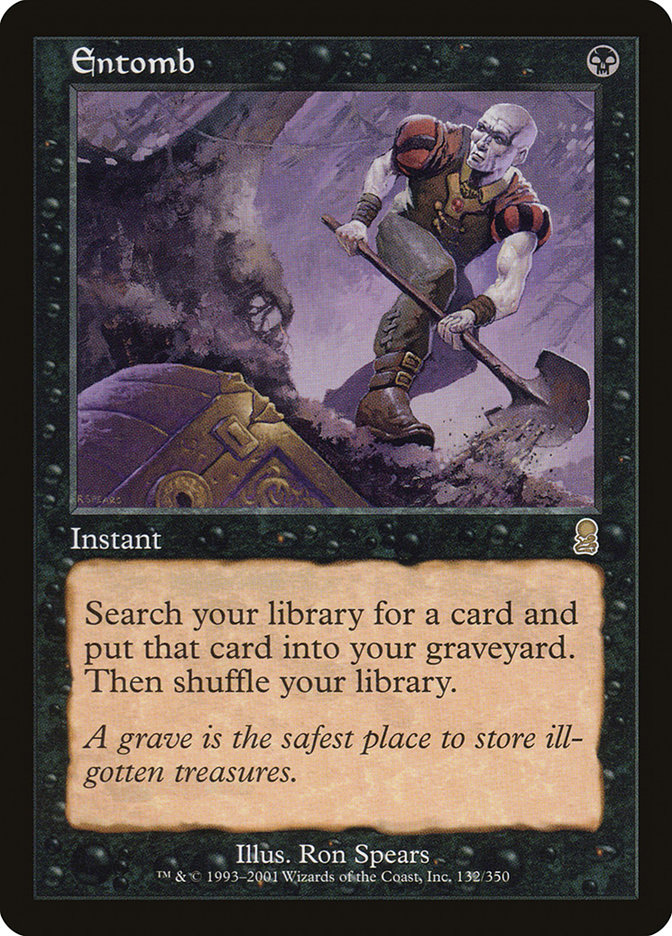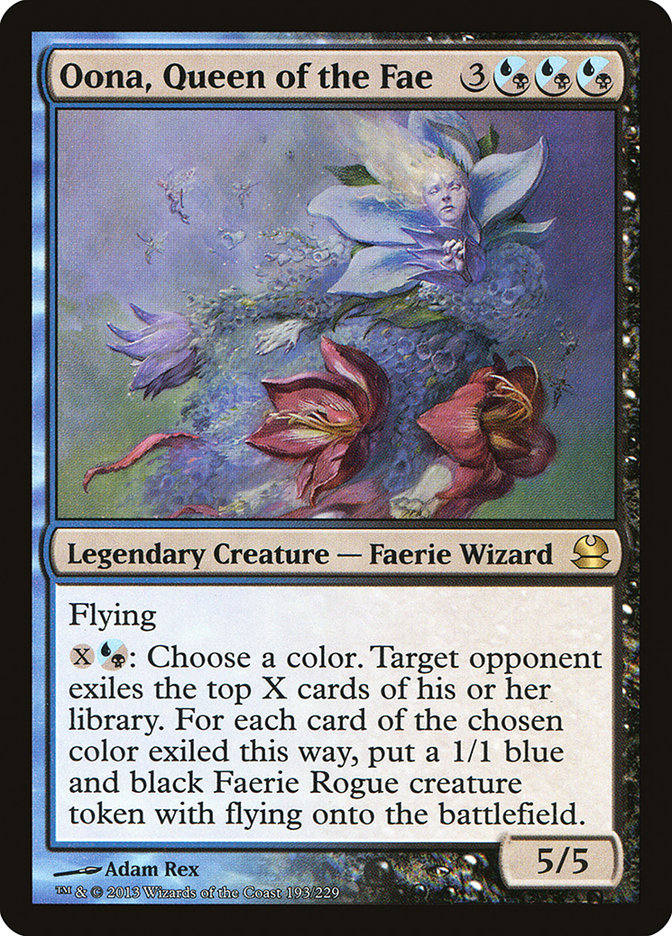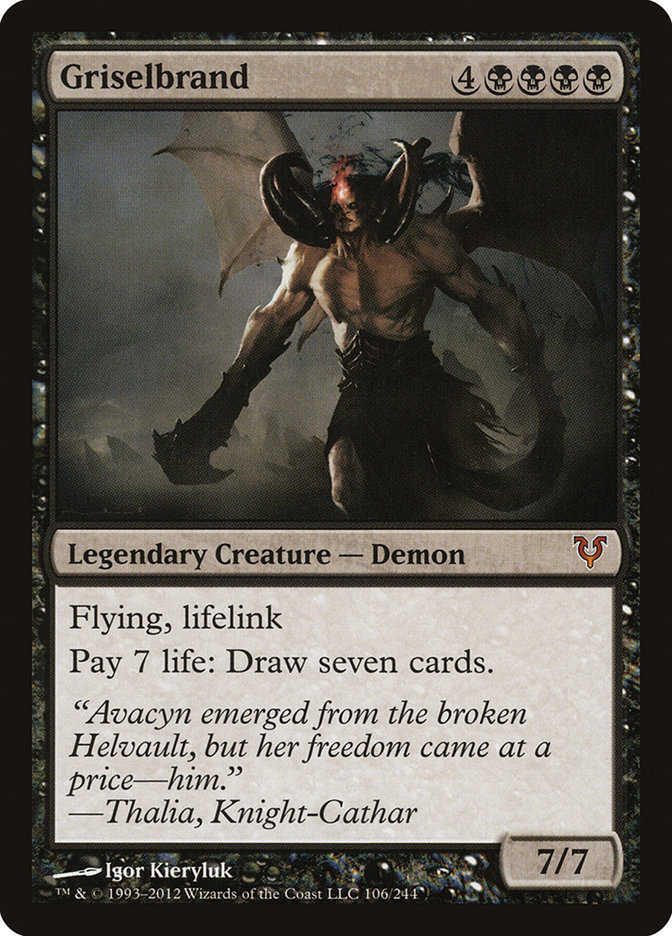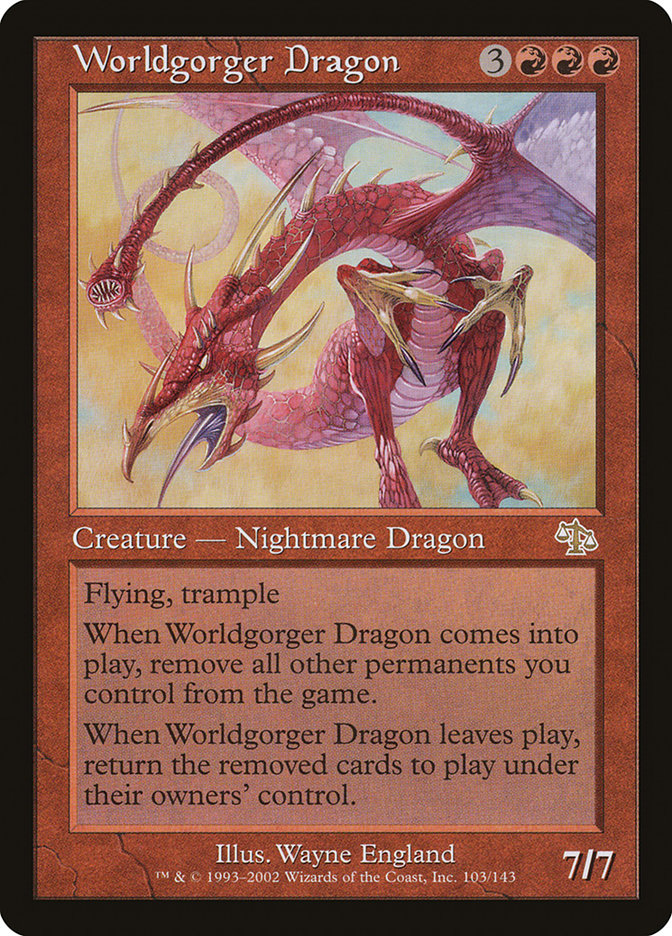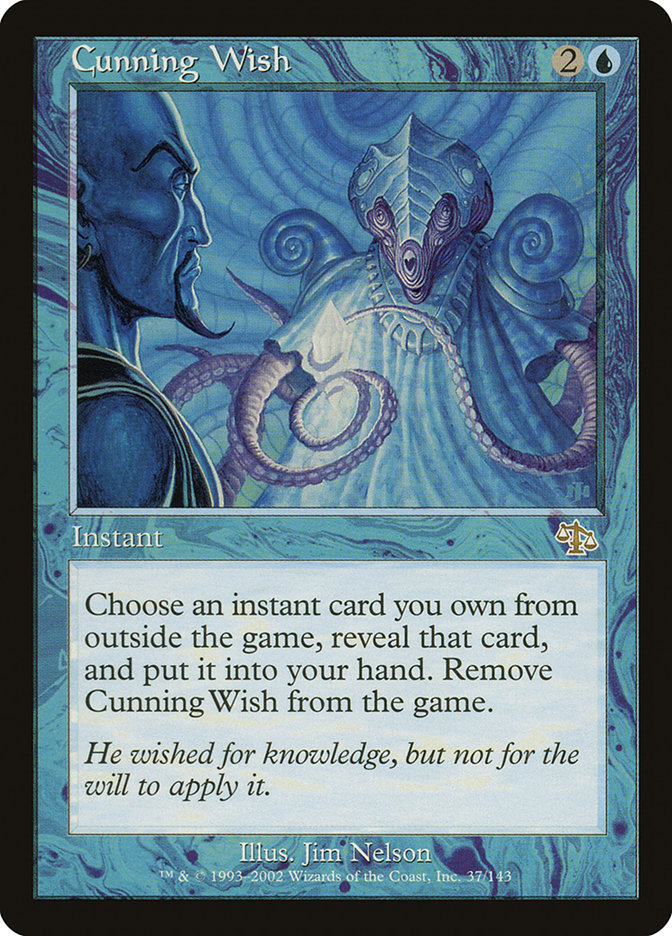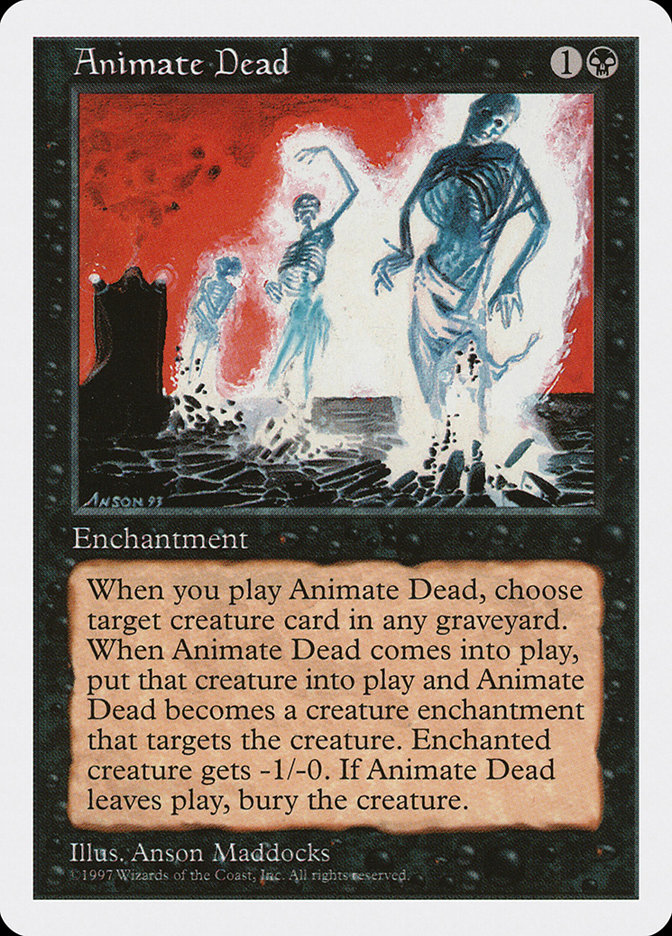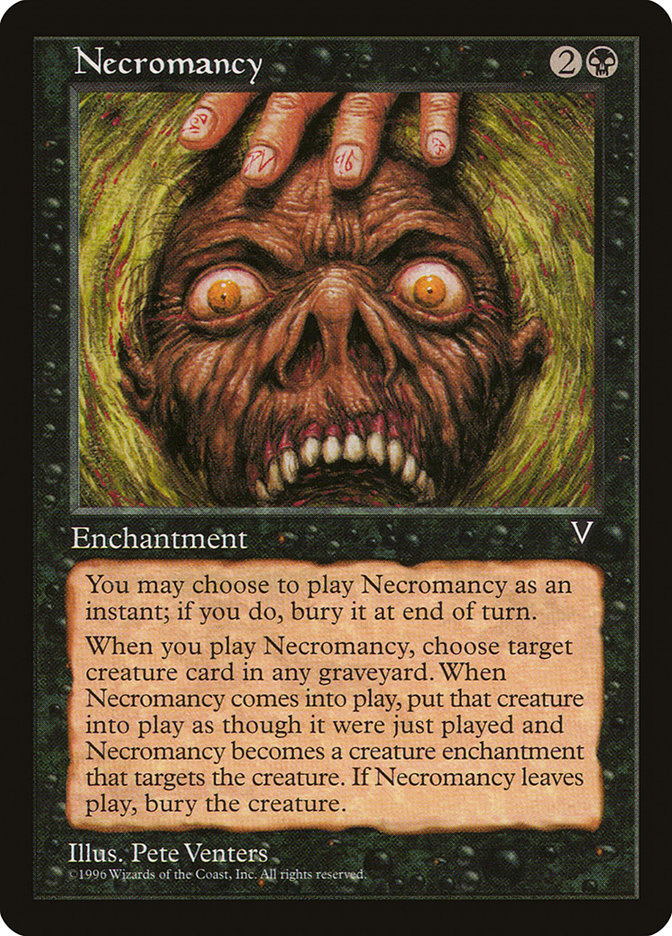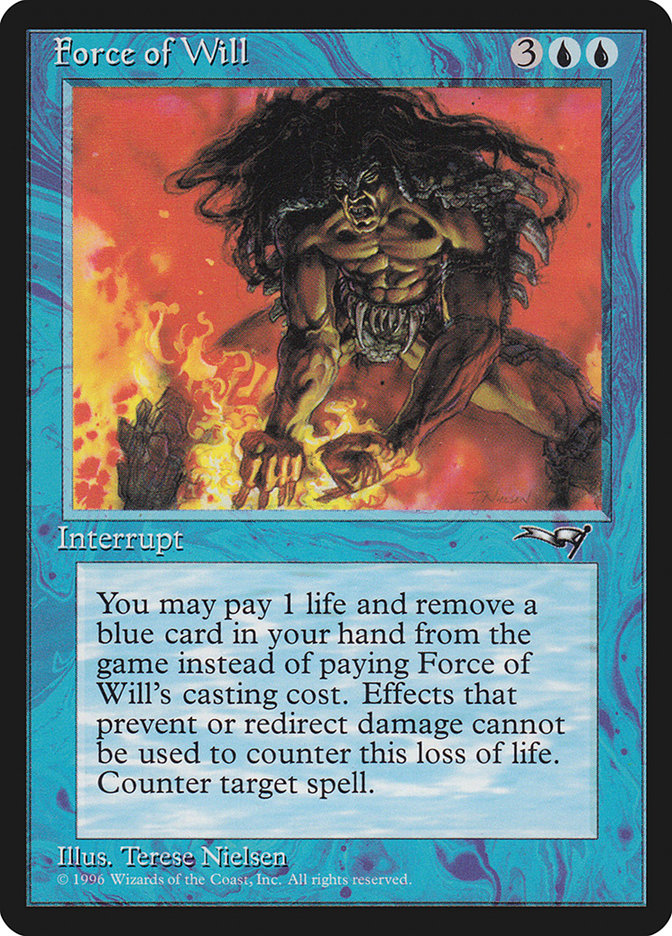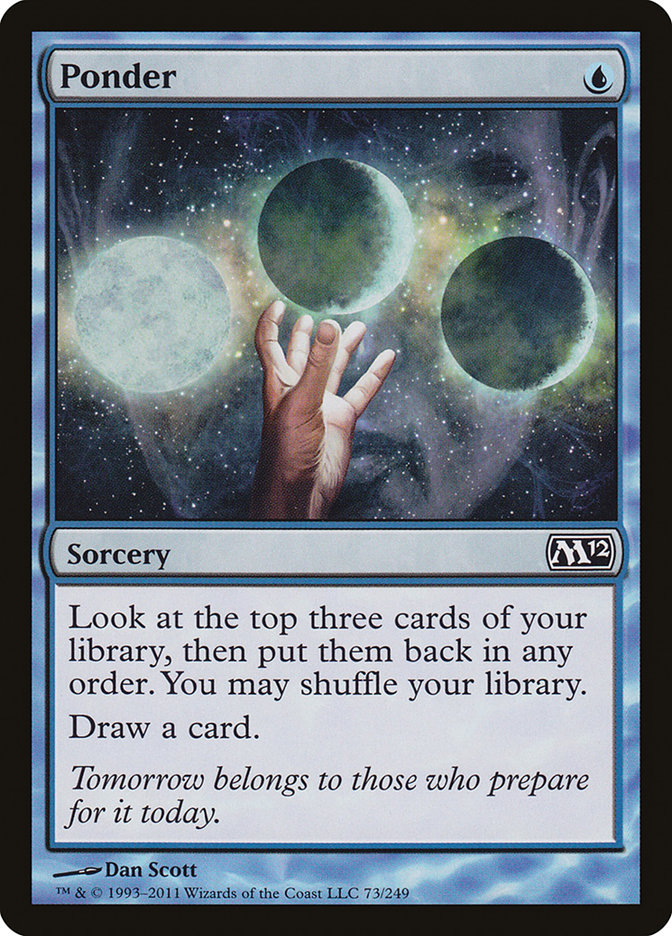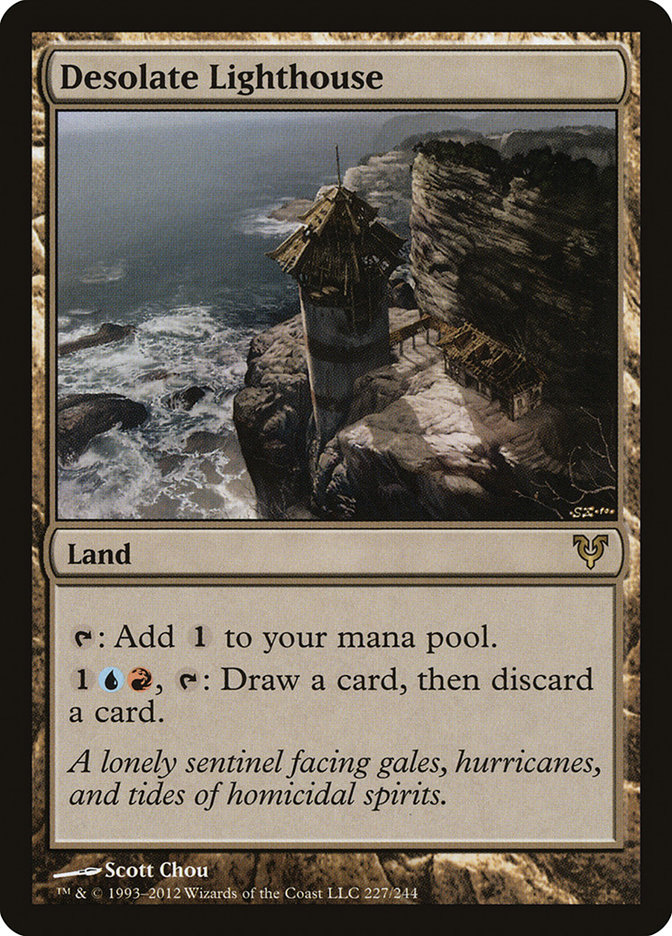I was wrong. In fact, a lot of us were wrong, I think. Whenever I thought or talked about Worldgorger Dragon being unbanned in the past, like a lot of
people, I just dismissed it as being essentially irrelevant because, honestly, why would you be trying to go for a three-card combo win instead of just
using two cards and putting Griselbrand into play? Nobody I talked to ever had a decent argument to refute this thought process so when they took it off
the list two weeks ago, I didn’t really expect it to make much of a splash. Actually, I expected it to be fringe playable at best, a strategy more employed
for nostalgia and sweetness than because it was actually any good.
Starting at the Beginning
As this rather lengthy introduction has probably already told you, I’m a lot less sure now. You see, after finishing last week’s offering, I found myself with the Magic equivalent of
that song you just can’t get out of your head – my thoughts just kept returning to the Dragon-brew I posted in that article.
That phenomenon is something I’ve started to recognize – it usually means that either a) something really sweet I really really want to make work is going
on or b) there’s something really good hidden somewhere I haven’t figured out yet. Given that I don’t think the Dragon combo is particularly sweet – well,
the whole drawing three+ games per round thing is pretty cute – I concluded I was missing something awesome.
So I went over my assumptions concerning Worldgorger Dragon again:
– Trying to reanimate Dragon ASAP just doesn’t make sense because Griselbrand is much better if you’re just trying to move in on turn 1 or 2 because it
uses fewer cards. So you have to be planning to play a slower game than Reanimator or Tin Fins, or you’re just playing a worse deck.
– The only two advantages of reanimating Dragon over some ridiculous legendary creature are that it wins on the spot when you do and that you’re immune to
Karakas (but vulnerable to basically everything else, up to and including Erase).
– Dragon is significantly more vulnerable than just about any other viable Reanimation target.
– If you want to Dragon, you want a lot of incidental ways of making the Dragon-loop lethal, and you want some of those ways to be part of your manabase to
move things as close to a two-card combo as possible.
– The biggest draw to Worldgorger combo is how cheaply it can win the game – just three mana, split up in batches on 1 and 2.
– You want as much library manipulation as possible – if feasible at instant speed – so as to find all three pieces as often as possible.
And then, suddenly, I knew what Dragon wanted to be: the way a combo control deck ends the game. Think about it. The pieces are all there. Your combo is
insanely vulnerable, so it needs to be exceedingly well-protected. You need to play a longer game simply to not be naturally outclassed by Griselbrand
already, while playing a longer game also helps to get the additional piece you need into position. Your combo is very cheap to pull off so you don’t need
to run mana acceleration to threaten early kills (there is no good mana acceleration for control decks in Legacy). You win on the spot, so the combo is a
great way to compensate for losing control of the board at a certain point. You want to have a lot of lands in your deck (compared to most combo decks)
because you want to use your manabase to help with profiting from the Dragon loop, and you naturally want a deck with an overwhelming amount of card draw
(which is the actual core functionality of any good combo-control deck).
Funnily enough, the B&R announcement that released Worldgorger Dragon from the banned list and got rid of Treasure Cruise also left us with probably
the most Legacy viable draw-engine for a dedicated combo-control deck ever printed:
Once I had made that connection, things suddenly fell into place as if by themselves. I’d been thinking about this deck in the wrong way. When I made last
week’s list, I was still approaching it from the mindset of a combo deck, a deck built around the idea of reanimating a Worldgorger Dragon for the win.
Instead I needed to think about the deck foremost as a control deck, albeit with the uncanny ability to just win on turn 2 or 3. The combo pieces were
nothing but the pay off, the way to end things on the spot once I had created an opening.
When I started thinking about Dragon as a Dig Through Time control deck instead of a combo deck, I found to my surprise that the list nearly built itself
aside from a couple of hard cuts towards the end. After some tinkering and shaving, this is where I’ve ended up:
Creatures (6)
Lands (20)
Spells (34)

If you think this is a weird way to build a combo deck, well, remember that this is a control deck. Your gameplan going in is that of something like
Golddigger where you’re drowning your opponent in card advantage. Lightning Bolt their creatures, discard and counter their spells, and gas back up with
Dig Through Time. Rinse and repeat until your opponent keels over from the sheer amount cards you’re ahead. Only instead of having to grind things out and
try to successfully stick a win condition and defend it, you get to kill people on the spot once you’ve created a safe opening – which might be as early as
turn 2.
Let me take a moment to go over the card choices.
You aren’t hellbent on being fast and as the deck is constructed, Entomb is mostly dead until you’re planning to win, so having less than the maximum
amount of copies isn’t a problem, especially given that the fourth turn’s Cunning Wish into a combo piece if needed is there. That being said, the fact
that Entomb allows you to win for only three mana makes it incredibly valuable to make the deck fast enough to play as a combo deck when that’s called for.
Definitely an oversight in last week’s list.
By the way, I considered running a couple of cute utility targets for Entomb – in fact, the first draft list had Darkblast, Crippling Fatigue, Deep
Analysis, and Faithless Looting. I cut all of them to get down to 60 and because I wanted to keep the number of bad cards in my deck to a minimum. There’s
a reason these cards usually don’t see play, after all. Darkblast is at this point the closest candidate for coming back (in place of the third Lightning
Bolt), but I’ve refrained so far because of how annoying Deathrite Shaman is and how hard that is to kill with Darkblast.
I want to run as few clunky slots as possible (drawing Entomb is almost always better in this list than drawing a fatty) so this is the minimum I think you
can get away with. You want two Dragons so that Entomb can still find one if you’ve drawn the other already, and Oona is the best straight finisher to run
because she’s a decent hardcastable threat and blue for Force of Will to boot (you want a finisher to make Entomb into something that wins you the game in
combination with an active loop, something Snapcaster Mage and Griselbrand can only do conditionally).
The singleton Griselbrand, on the other hand, gives you a complete secondary mode of operations and is something I think no single Worldgorger Dragon brew
should be without simply because it allows you to imitate Reanimator’s two-card combo early (mitigating much of Dragon’s three-card combo problem in the
earlygame). Even more importantly for this deck, it allows you to play Trix. If you aren’t sure you can defend the Dragon-loop, just reanimate a
Griselbrand and draw seven to fourteen cards. Even if the big bad demon of doom gets dealt with, all those extra cards should allow you to set up a full
combo win with massive protection a turn or two down the road. Definitely consider drawing the first seven as soon as Griselbrand hits play, by the way.
Being able to discard a drawn Worldgorger Dragon can easily be a boon.
The Lightning Bolts are easy to explain. You can’t get away with playing a control game in Legacy without the ability to kill Delver of Secrets, Stoneforge
Mystic, and Deathrite Shaman. Lightning Bolt is the most flexible, mana efficient way to do so in our colors. I list Snapcaster Mage and Cunning Wish with
the Bolts because the majority of the time, that’s what these cards will play as – extra answers. Snapcaster recurs Lightning Bolts and all of your discard
spells to make sure you can keep up a constant flow of answers without clogging your deck with too many narrow cards, and Cunning Wish is the same, with
the bonus of giving you answers to anything the opponent might deploy (even if it often is only through Echoing Truth – maybe this is finally the deck that
wants Chaos Warp?).
At the same time, Snapcaster Mage plus Cunning Wish works as a secondary win package that allows you to turn Desolate Lighthouse plus the Dragon Loop into
a win even if you’re empty-handed (you want one so that you can pitch Oona to Force of Will) and can serve as the third piece to complete the Dragon combo
to boot (use Snapcaster to Flashback the Entomb to find Oona).
You want to be able to regularly leverage your combo in the earlygame, if only to punish people for giving you openings and to be able to successfully race
against other combo decks that can’t actually threaten the Dragon, making some number of two-mana reanimation spells unavoidable. You also definitely want
to have regular access to Necromancy because it allows you to punish people for greedy end of turn plays and being able to win completely at instant speed
is actually quite a powerful tool to have access to when you’re trying to play through a ton of ways they might interact with you.
The correct split might actually be 4-2 in favor of Animate Dead though, simply because the whole instant speed thing tends to come up later in the game,
and the mana mattering is important from turn 2 onwards. I also think the deck might be able to get away with just five reanimation effects overall
(probably cutting a Necromancy because the instant speed thing tends to come up in the lategame), but I’m afraid things might just become too hard to set
up in a reasonable time frame at some point.
One thing I want to point out is that you shouldn’t be afraid to spend your reanimation effects for value, which is why I’m on all Animate Dead instead of
a split with Dance of the Dead. When I use these as utility spells, I want to get untapped creatures to (chump) block with. Casting Animate Dead to rebuy
another Snapcaster Mage trigger is perfectly fine and so is stealing your opponent’s dead creatures should the opportunity arise. You generally don’t need
more than a single reanimation spell on your combo turn due to the nature of the Dragon loop (where it being stopped usually ends in you not having
permanents) leading you towards a playstyle that delays going off until it’s perfectly safe to do so naturally anyway.
Force of Will should be obvious by now, and you want discard as disruption because it allows you to know you’re safe as well as being an answer to
something like Abrupt Decay. I originally envisioned this deck with Gitaxian Probe and Cabal Therapy instead of Thoughtseize, but that simply won’t fit
into 60 cards as long as you insist on running removal – and I think it would be a huge mistake to not do so.
Not having Probe means you can get away with running the full four copies of Thoughtseize, and it’s worth it to my mind. Thoughtseize can hit annoying
creatures such as Scavenging Ooze, Tarmogoyf, and Deathrite Shaman and can also serve as a viable discard outlet for an in-hand Dragon in a pinch. Duress
is the next best option because I’m uncomfortable running Therapy in a deck with this few creatures without Gitaxian Probe.
I originally wanted (and still want) a sixth discard spell for a nice round ten pieces of dedicated disruption but ran afoul of wanting to stick to 60
cards. The second Duress was the last thing I cut (just so you all know what will get added to the deck if I decide to try out running only five
reanimation effects).
The cantrips should be obvious given what the deck is about, and Dig Through Time is what gives the deck its flexibility. It’s great at finding combo
pieces, it’s great at finding answers, and it’s even an instant so that you can cast it with dragon-produced mana when you’ve been forced into the loop.
Note that it can even be used to break the loop by delving away the Worldgorger Dragon once you have sufficient mana (might prove useful with an
in-hand Oona or a bunch of Ponder).
The Loothouse is the secret key to how the deck is built. It isn’t particularly good at any one thing – it’s a mediocre mana source (colorless), it’s a
mediocre way to get a drawn Worldgorger Dragon into the yard (four mana including itself), it’s a mediocre card quality tool for drawn out games, it’s a
(very) mediocre way to fuel your delving, and it’s a rather demanding way to make the Dragon-loop lethal (it asks you to have access to both blue and red
mana, plus black for the animate spell) – but it’s all those things. Desolate Lighthouse isn’t a great card in a vacuum, but it’s exactly what
this deck needs.
So then…about those basics.
I’ve built a surprising amount of twenty mana source control decks for Legacy (and this has arguably fewer lands given that four are colorless), and one of
the things I’ve learned is that having enough basics to be able to operate at full capacity with nothing but those basics in play can often make the
difference between winning and losing. They’re a bit awkward at times (you want at least double black on your combo turn to cast discard plus a reanimate
effect and sometimes even triple so as to cast Entomb), and you’ll find yourself risking Wasteland in spite of them being in the deck just to make sure you
can both Thoughtseize on turn 1 and Ponder on turn 2, but overall this kind of manabase tends to win me a lot more games than it’s losing. I’d love to have
room for a third Underground Sea against Wasteland decks admittedly, but you can’t have everything (Dig is important enough to justify the second Island in
my mind).
The Sideboard
I’m reasonably sure you can figure out the uses for most of the Wish targets easily, and I’m also reasonably sure I’m missing a couple of nice options that
should replace some things. Don’t cut the Dig Through Time though, as you really want your Wishes to be fully functional as additional means to accrue card
advantage when you’re grinding.
The Flusterstorms may look like Wish-targets, but they’re actually meant to be boarded in for the Lightning Bolts or some of your Animate Deads in matchups
where you feel you need more disruption. That leaves the Academy Ruins + Engineered Explosives package, reminiscent of Golddigger (which is what I cribbed
it from). The reason to have these seemingly out of place cards is that it is the perfect inevitability tool for the deck. Just having these pieces means
you will eventually grind through almost any amount of lockdown against Miracles, they answer Rest in Peace (one of the two pieces of graveyard hate you
actually care about because it shuts down Dig Through Time), and the Explosives play perfectly with the control plan as extremely flexible pieces of
removal when there is no hate to answer.
There are mainly two other actual sideboard cards I’ve been considering: Vendilion Clique and Jace, the Mind Sculptor. Vendilion Clique is great disruption
(if a little pricey), and its mere presence in the deck makes it possible to sometimes turn your reanimation effects into disruption, which I could easily
see being convenient in certain matchups.
Jace on the other hand, just gives you a completely different angle of attack in matchups where you expect your opponents to have overwhelming amounts of
answers to your combo after sideboard. The deck definitely plays control well enough to win like an actual control deck, especially against blue midrange
and control decks that have a bunch of Swords to Plowshares and graveyard hate in their deck after sideboard.
One final note on the sideboard. Committing ten slots to Wish targets when you only play two copies of Cunning Wish might seem like a waste. However, what
I’ve found so far is that the deck really doesn’t want to sideboard much anyway because there are so few cards you can actually sideboard out. The
fatty-package is already the minimum I would run, you don’t want to touch lands or your library manipulation package, and you need to keep all of your
disruption in because you’re either playing against combo (where disruption is key) or against something that will have a ton of ways to stop you from
killing them (seeing as how your combo is vulnerable to just about everything). That leaves the Lightning Bolts and parts of your combo as the only things
you should consider boarding out, meaning there are only roughly three to four slots to play with in any given matchup.
A Short Exposition
Once I had built the deck, I was pretty excited. It just looked so right on paper that I was itching to play it, even though I expected it to perform
significantly below my excitement level – it’s just a wonky Worldgorger Dragon brew, after all. Fast forward to our local After Work Legacy event on
Thursday evenings where I was going to play my very first games with Worldgorger Dragon in more than a decade and still expected to find the deck clunky
and vulnerable compared to your regular Legacy contender. Here’s a Q’n’D (quick and dirty) of the four rounds we played:
Round 1 (Punishing Jund)
Game 1: He opens on Bayou, Deathrite Shaman. I’ve won the die roll and end of turn Entomb, my turn cast Animate Dead with Cunning Wish in hand.
Yes, it does feel good to have the nuts round 1 game 1.
Game 2: Dark Confidant buries me because I decide to kill Deathrite Shaman instead. Need to remember what my deck is all about.
Game 3: I kill all his creatures and discard all his relevant cards, then cast Animate Dead.
Round 2 (Loam Pox)
Game 1: I Animate Dead Griselbrand and let him Vindicate it because I know he also has an Abrupt Decay. The Bargain activation is enough.
Game 2: He has turn 2 Chalice on one. I have Entomb into Animate Dead on my turn with a Cunning Wish in hand.
Round 3 (Miracles)
Game 1: I Thoughtseize his Top, Force of Will his Counterbalance, and grind him out, manually activating Desolate Lighthouse at least half a dozen times.
Game 2: I destroy his Counterbalance with Red Elemental Blast and proceed to grind him out, essentially in control from that point onwards.
Round 4 (Sultai Delver with Standstill)
Game 1: I make the huge mistake of Entombing Worldgorger Dragon instead of Griselbrand when he is on two unknown cards, and I have Animate Dead plus Force
of Will back up. I realize my mistake in time, but I’m stuck on two mana, so I go for it anyway, and he has the Abrupt Decay
Game 2: He has turn 1 Grafdigger’s Cage and plays another on turn 3. I haven’t boarded in my Engineered Explosives and decide then and there it’s hardcast
Oona time. Fast forward a lot of turns, and I have seven mana and Thoughtseize into hardcast Oona with a bunch of Forces for backup against his hand full
of Abrupt Decays and graveyard hate.
Game 3: I don’t Force of Will his turn 2 Grafdigger’s Cage; Brainstorm away combo pieces all game for more mana, removal, and card draw; use his Standstill
as an opportunity to keep activating Desolate Lighthouse (forcing him to eventually break his own Standstilll); and finally Engineered Explosives away a
board with an unflipped Delver, Deathrite Shaman, and two Grafdigger’s Cages. I win this game by discarding Worldgorger Dragon and Oona to hand size before
casting Necromancy during his upkeep.
Conversion Experience
Now I know this was a local event, casual atmosphere and non-optimal decks and play included. The fact that I won that event isn’t why I’m writing about
the deck today. I’d just discount this as a combination of luck, soft opposition, and low sample size easily – if it wasn’t for one thing: I’ve been
playing for a long time and when I start playing a deck, it usually doesn’t take me long to get a feel for how good the deck is inherently – a feel that is
very rarely wrong. And the Dragon deck felt awesome.
The deck flowed extremely smoothly, it switched roles like nobody’s business, created a ton of valid lines of play and angles to attack from, could win
both on turn 3 and turn 30 with equal ease, and made things incredibly awkward for my opponents. Given that the deck is capable of winning on turn 2 and at
instant speed, there simply are very few points in time for your opponent to tap out and feel safe.
The Worldgorger Dragon combo is kept in check theoretically by the fact that everybody is going to have a ton of interaction for it. Once they tap out
though, you suddenly only care about exactly the same thing as every other combo deck – Force of Will. What’s more, Dragon has its own Force of Wills,
meaning that even tapping down partially might make it so that they die with multiple copies of relevant interaction in hand. As a result, your opponents
are forced to spend their mana extremely inefficiently. You, on the other hand, get to spend all of your mana freely every single turn. You even have
Loothouse as a mana sink in the lategame to minimize the chance of drawing a string of blanks.
The resulting tension puts your opponents between a rock and a hard place, forced to play incredibly defensively because of the threat of your combo kill,
all the while losing the card advantage war as a result of the incurred inefficiencies in casting their spells.
In short, just from playing a couple of games with what should by all rights still be a rough brew, Enter The Dragon felt not just viable but actually like
a top tier deck. It just exploits the inherent dynamics of a Legacy game exceedingly well in spite of being built around an interaction that seems both
clunky and extremely vulnerable. I’m super excited to get to play more with the deck, and if it keeps playing out the way it has, there’s a good chance it
might even displace Storm as my deck of choice for important events (and if you follow this column, you all know how unlikely that is to happen).
Note: I’m not saying that the sky is falling and unbanning Worldgorger Dragon was a huge mistake. On the other hand, while the deck might still turn out to
be a lot worse than it has felt so far given the low number of games I played with it, I’m definitely convinced we were undervaluing what the combo can do
completely when discussing how in heaven that brick of a card was still on the list in the past. Worldgorger Dragon is good, it just isn’t what we thought
it would be.



